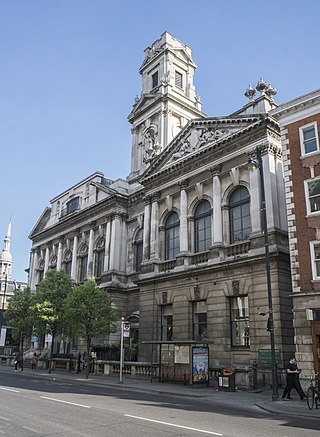
Poplar was a local government district in the metropolitan area of London, England. It was formed as a district of the Metropolis in 1855 and became a metropolitan borough in the County of London in 1900. It comprised Poplar, Millwall, Bromley-by-Bow and Bow as well as Old Ford, Fish Island and Cubitt Town.

The Metropolitan Borough of Shoreditch was a metropolitan borough of the County of London between 1899 and 1965, when it was merged with the Metropolitan Borough of Stoke Newington and the Metropolitan Borough of Hackney to form the London Borough of Hackney.

Hackney Central is a sub-district of Hackney in the London Borough of Hackney in London, England and is four miles (6.4 km) northeast of Charing Cross.

Shoreditch Town Hall is an independent cultural, live events and community space in Shoreditch, London. The building, which previously served as the headquarters of the Metropolitan Borough of Shoreditch, is a Grade II listed building.

Hackney London Borough Council, also known as Hackney Council, is the local authority for the London Borough of Hackney, in Greater London, England. It is a London borough council, one of 32 in London. The council has been under Labour majority control since 2002. Since 2002 the council has been led by a directly elected mayor. The council meets at Hackney Town Hall and has its main offices in the adjoining Hackney Service Centre.

Camden Town Hall, known as St Pancras Town Hall until 1965, is the meeting place of Camden London Borough Council. The main entrance is in Judd Street with its northern elevation extending along Euston Road, opposite the main front of St Pancras railway station. It was completed in 1937 and has been Grade II listed since 1996.

Islington Town Hall is a municipal facility in Upper Street, Islington, London. The town hall, which is the headquarters for Islington London Borough Council, is a Grade II listed building.

Hendon Town hall is a municipal building in the Burroughs, Hendon, London. The town hall, which serves as a meeting place for Barnet London Borough Council, is a Grade II listed building.

The Old Town Hall was a former municipal facility at the corner of King Street and Rodney Street in Wigan, England. The building, which was demolished in September 2013, had been designated a Grade II listed building in 1990.

Kensington Town Hall is a municipal building in Hornton Street, Kensington, London. It is the headquarters of Kensington and Chelsea London Borough Council.

Hammersmith Town Hall is a municipal building on King Street in Hammersmith. The town hall, which is the headquarters of Hammersmith and Fulham London Borough Council, is a Grade II listed building.

The new Town Hall is a former technical college in Library Street, Wigan, England which was converted into a municipal facility in 1990. It is a Grade II listed building.

The old Town Hall is a former municipal facility in North Street, Wolverhampton, West Midlands, United Kingdom. It is a Grade II listed building.

Greenwich Town Hall is a municipal building on Royal Hill, Greenwich, London. It is a Grade II listed building.

Stoke Newington Town Hall is a municipal building in Church Street, Stoke Newington, London. It is a Grade II listed building.

Lewisham Town Hall is a municipal building in Catford Road, Lewisham, London. The oldest part of the facility, the curved former municipal offices and adjoining concert hall of 1932, is a Grade II listed building. The complex also includes newer wings from the 1950s to 1970s; those serve as the headquarters of Lewisham London Borough Council.

Wandsworth Town Hall is a municipal building on the corner of Wandsworth High Street and Fairfield Street in Wandsworth, London. The building, which is the headquarters of Wandsworth London Borough Council, is a Grade II listed building.

Marylebone Town Hall, also known as the Westminster Council House, is a municipal building on Marylebone Road in Marylebone, London. The complex includes the council chamber, the Westminster Register Office and an educational facility known as the Sammy Ofer Centre. It is a Grade II listed building.

Batley Town Hall is a municipal facility in the Market Place in Batley, West Yorkshire, England. It is a Grade II listed building.

The Old Town Hall is a municipal building in Mare Street in Hackney, London. The building, which is currently used as a public house, is a Grade II listed building.





















